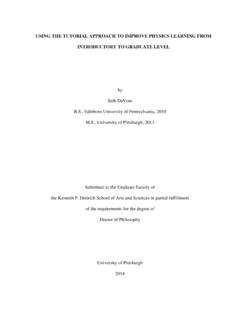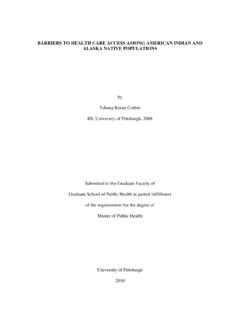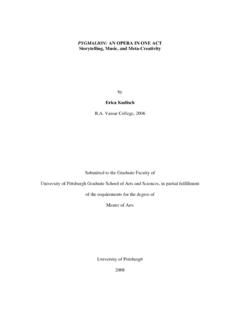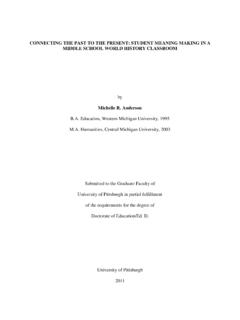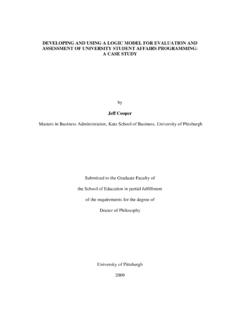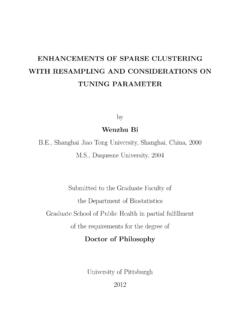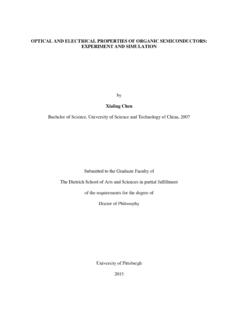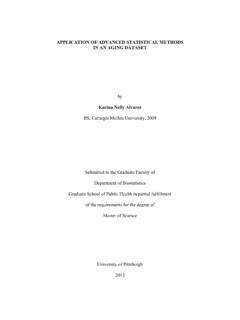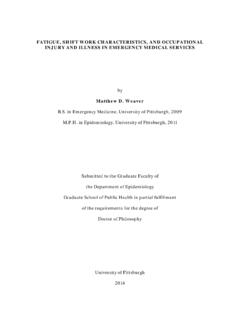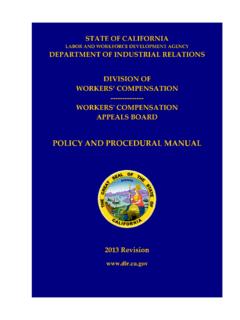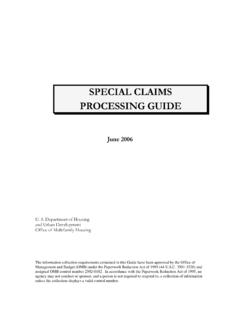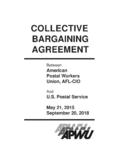Transcription of A COMPARISON OF KAPLAN-MEIER AND …
1 A COMPARISON OF KAPLAN-MEIER AND cumulative incidence ESTIMATE. IN THE PRESENCE OR ABSENCE OF COMPETING RISKS IN BREAST CANCER. DATA. by Bintu N. Sherif , University of Pittsburgh, 2004. Submitted to the Graduate Faculty of Graduate School of Public Health in partial fulfillment of the requirements for the degree of Master of Science University of Pittsburgh 2007. UNIVERSITY OF PITTSBURGH. Graduate School of Public Health This thesis was presented by Bintu N. Sherif It was defended on December 14, 2007. and approved by Vincent C. Arena, PhD, Associate Professor, Department of Biostatistics, Graduate School Public Health , University of Pittsburgh Christine E. Ley, PhD,MPH,MSW, Associate Director, Behavioral and Community Health Sciences, Graduate School Public Health, University of Pittsburgh John W. Wilson, PhD, Assistant Professor, Department of Biostatistics, Graduate School Public Health , University of Pittsburgh Jong-Hyeon Jeong, PhD, Associate Professor , Department of Biostatistics, Graduate School of Public Health, University of Pittsburgh Thesis Advisor ii Copyright by Bintu N.
2 Sherif 2007. iii A COMPARISON OF KAPLAN-MEIER AND cumulative incidence . ESTIMATE IN THE PRESENCE OR ABSENCE OF COMPETING RISKS IN. BREAST CANCER DATA. Bintu N. Sherif, University of Pittsburgh, 2007. Statistical techniques such as KAPLAN-MEIER estimate is commonly used and interpreted as the probability of failure in time-to-event data. When used on biomedical survival data, patients who fail from unrelated or other causes (competing events) are often treated as censored observations. This paper reviews and compares two methods of estimating cumulative probability of cause-specific events in the present of other competing events: 1 minus KAPLAN-MEIER and cumulative incidence estimators. A subset of a breast cancer data with three competing events: recurrence, second primary cancers, and death, was used to illustrate the different estimates given by 1 minus KAPLAN-MEIER and cumulative incidence function. Recurrence of breast cancer was the event of interest and second primary cancers and deaths were competing risks.
3 The results indicate that the cumulative incidences gives an appropriate estimates and 1. minus KAPLAN-MEIER overestimates the cumulative probability of cause-specific failure in the presence of competing events. In absence of competing events, the 1 minus KAPLAN-MEIER approach yields identical estimates as the cumulative incidence function. The public health relevance of this paper is to help researchers understand that competing events affect the cumulative probability of cause-specific events. Researchers should use methods such as the cumulative incidence function to correctly estimate and compare the cause- specific cumulative probabilities. iv TABLE OF CONTENTS. 1. ESTIMATORS OF cumulative PROPOTION UNDER COMPETING 4. THE HAZARD FUNCTION ESTIMATE .. 4. KAPLAN MEIER 5. COMPETING RISK .. 7. cumulative incidence 10. BREAST CANCER DATA .. 11. BREAST CANCER 11. BREAST CANCER DATASET .. 11. METHODS .. 13. STATISTICAL METHODS .. 14.
4 RESULTS .. 14. COMPARISON IN THE PRESENCE OF COMPETING 14. COMPARISON IN THE ABSENCE OF COMPETING EVENTS .. 19. DISCUSSION .. 21. APPENDIX A: PROGRAM CODE .. 22. BIBLIOGRAPHY .. 28. v LIST OF TABLES. Table 1: 1-KM and CI estimates for the first 5 breast cancer data observations .. 15. Table 2: Selected observations of CI and 1 - KM for the breast cancer data .. 16. Table 3: 1-KM and CI COMPARISON .. 18. Table 4:1-KM and CI COMPARISON in the absence of competing events .. 20. vi LIST OF FIGURES. Figure 1. An example of a Kaplan Meier 6. Figure 2. 1- KM estimate and the CI estimate of recurrence for the breast cancer dataset .. 16. Figure 3. The difference between 1-KM and 17. Figure 4. 1-KM and CI estimates in the absence of competing 19. vii PREFACE. I would first and foremost like to thank my thesis advisor Dr. Jong-Hyeon Jeong, for all the help and guidance he has provided during the work on this thesis. He has not only assisted me with his excellent advice, but he also elevated my interest in survival analysis, introduced me to a new statistical software package and improved my comprehension of theoretical statistics.
5 Second, I would like to thank my thesis committee members, Dr. Vincent Arena, Dr. Christine Ley and Dr. John Wilson. Thanks to Dr. Arena and Dr. Wilson for contributing greatly to my learning of biostatistics in my graduate study, and willingness to consult with me about problems encountered. Thanks to Dr. Ley for helping me understand different aspects of community health science theories. I am also grateful to everyone at the department for adding some pleasure to the work. I. would especially like to thank Phyllis Fisher who always listened and provided encouraging words. Finally, I would like to thank my parents, Seku and Hawa, my sisters, Maryam, and Fatima, brother, Malik, as well as my friends Genevieve and Solomon for their unconditional love and support. I am blessed and proud to call them my family. viii INTRODUCTION. Statistical techniques such as KAPLAN-MEIER product limit estimate (Kaplan and Meier 1958), which take into account censored data, are primarily used in the medical and biological sciences for estimating the probability of failure in time-to-event data survival data.
6 The term survival data is widely used to describe data involving time to the occurrence of an event. Events may be death, the appearance of a cancerous tumor, the development of some disease, recurrence of a disease, cessation of smoking, conception, and so forth. We have also seen survival analysis widely been used in the social sciences, where interest is on analyzing time to events such as job changes, marriage, birth of children and so forth. The engineering sciences have also contributed to the development of survival analysis which is called "reliability analysis" or "failure time analysis" in this field, since the main focus is in modeling the time it takes for machines or electronic components to break down. The developments from these diverse fields have for the most part been consolidated into the field of "survival analysis". (Allison, 1984). In the past decades, applications of the statistical methods for survival data analysis have been extended beyond biomedical and reliability research to other fields, for example, felons' time to parole (criminology), length of newspaper or magazine subscription (marketing), workmen's compensation claims (insurance), health insurance practice, business and economics.
7 The study of survival data has previously focused on predicting the probability of response, survival, or mean lifetime, and comparing the survival distributions of experimental 1. animals or of human patients. In recent years, the identification of risk and/or prognostic factors related to response, survival, and the development of a disease has become equally important (Lee (1992) Ch. 1). The analysis of survival data can be complicated by issues of censoring. In biomedical data, censoring arises when an individual's life length is only partially known in a certain period of time. Types of censoring includes right censoring- where the event occurs after the follow-up time, left censoring- where the event time occurred before the observation time, or interval censoring, where observation is not continual, but occurs at discrete times. Only the times between which the event occurred is known. Censored observations are contributed not only by losses to follow-up but also by deaths from other causes and sometimes by other events if they preclude development of the endpoint under consideration (Pepe, 1991).
8 For example, in a study of the disease-free survival in lymph node-negative breast carcinomas (Kuru et al study, 2003). patients with pathologically proven breast carcinoma and with negative axillary lymph nodes, who had been operated on for primary breast cancer, were followed-up for 60 months. The primary event of interest was death due to breast carcinoma. Patients who died from causes other than breast carcinoma were treated as censored observations. Many other studies tend to use the same type of approach; including Martinez (2007) in which the primary event of interest was AIDS related deaths (if the primary cause of death was an AIDS-defining condition) and death by other causes were censored. Ideally, the survival period is determined by following a group of patients until each of them has been reviewed for a set period of time or until an event has occurred. Emerging evidence now suggests that in the presence of competing risks, which will be further discussed, the cumulative incidence function, a method which takes into account competing risks 2.
9 Occurrence, is the appropriate method use to estimate the probability of occurrence of the event of interest in the presence of other events. However, researchers often use the Kaplan Meier approach (1-KM) to evaluate the survival probability of occurrence of a cause-specific endpoint, even if the appropriate data contain competing-risk events (Gooley, Leisenring et al. 1999). In the clinical oncology and epidemiology literature it is still quite common to see this probability incorrectly estimated as the 1 - KM estimator (Gaynor et al., 1993). This could result in an over- estimation of the cumulative probability of cause-specific failure. There can be different types of failure in a time-to-event analysis under competing risks. For illustration purposes I will make the same assumption as Gooley et al (1999), that is, the existence of two failure types; events of interest and all other events. This paper evaluates the advantages and statistical appropriateness of using the cumulative incidence estimate over the Kaplan Meier estimates (1-KM) method in biomedical survival analysis under right censoring.
10 The introduction and background are presented in Section 1. Section 2 reviews the hazard function estimate, commonly used the Kaplan Meier approach and the cumulative incidence estimate, as well as the definition of competing risks. Section 3 contains the description of a breast cancer dataset, used for COMPARISON and illustrates the difference between cumulative incidence estimate and the 1 minus Kaplan Meier estimate. Section 4 contains the Statistical methods. Numerical results of comparing the two types of estimates are provided in Section 5. Section 6 is a discussion of the results, limitations, suggestions for possible future application of this method, and suggested modifications of this method to fit different types of competing risks. 3. ESTIMATORS OF cumulative PROPOTION UNDER COMPETING RISKS. THE HAZARD FUNCTION ESTIMATE. A central quantity in survival analysis is the hazard function, (also known as the failure rate, hazard rate, or force of mortality).
